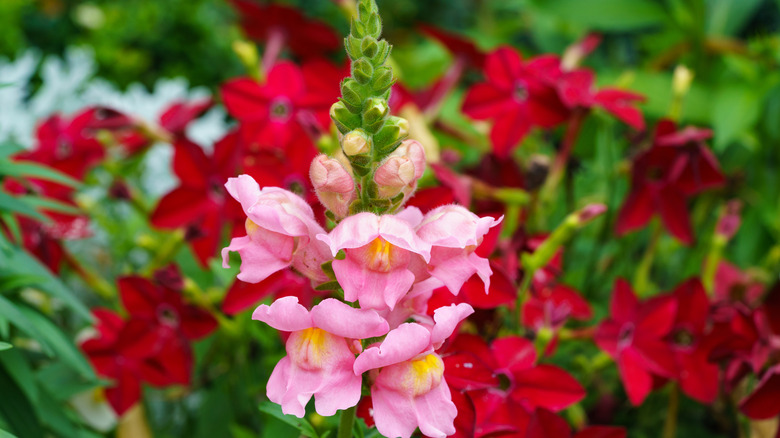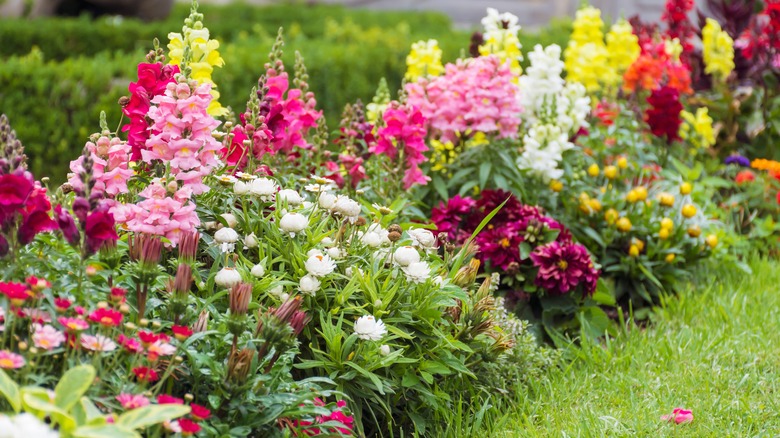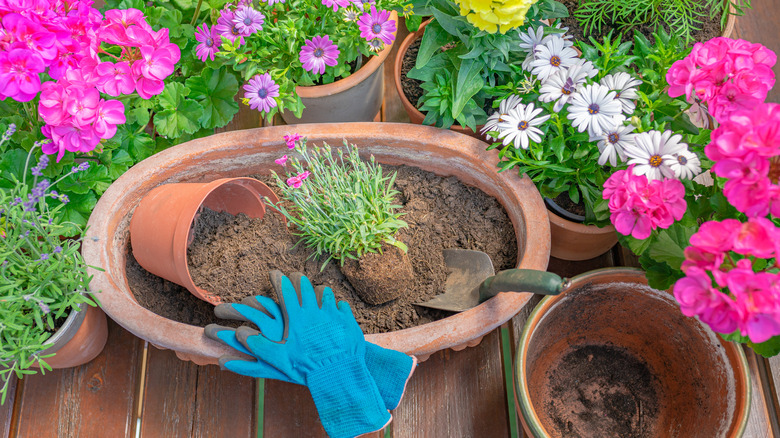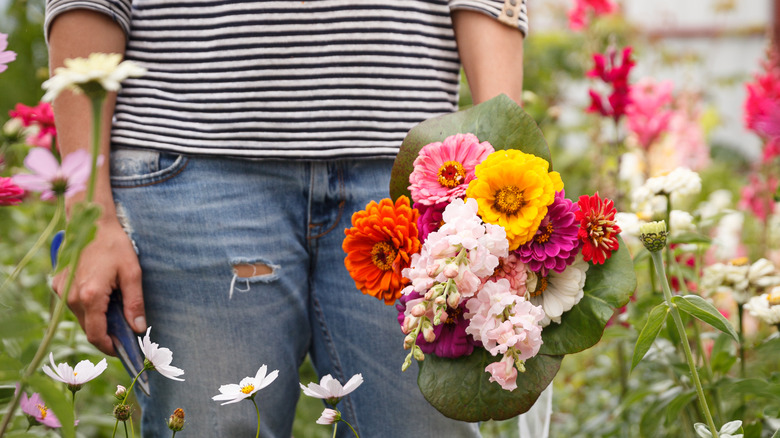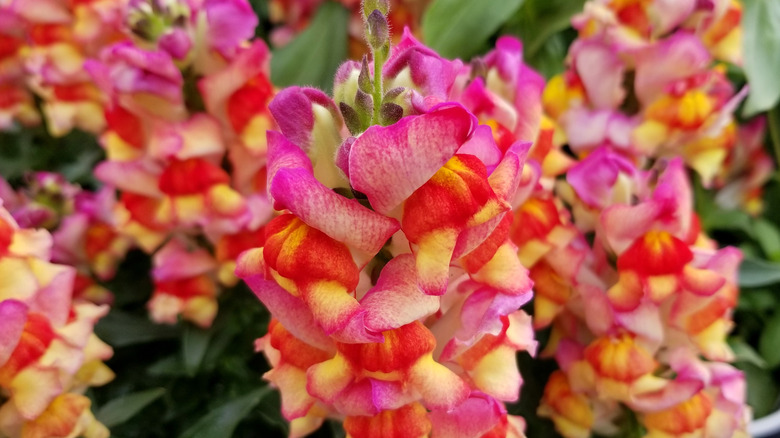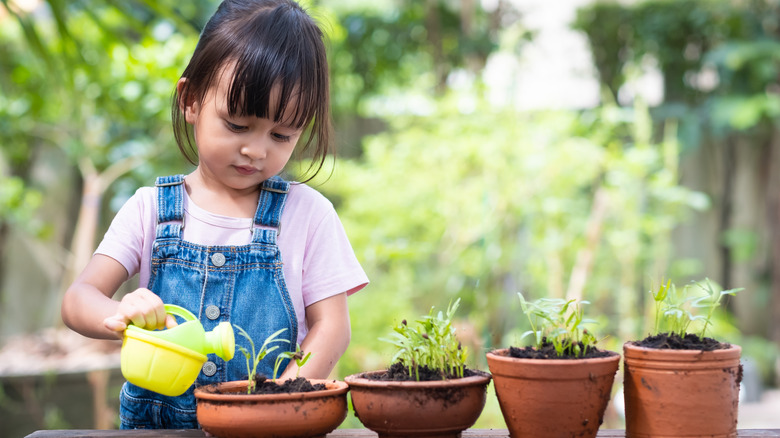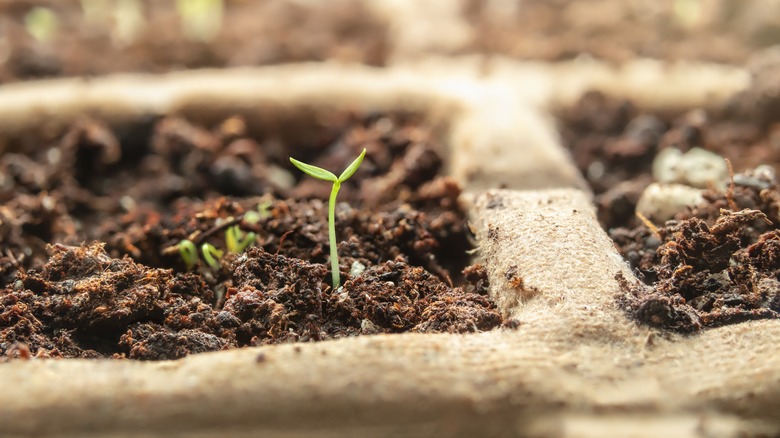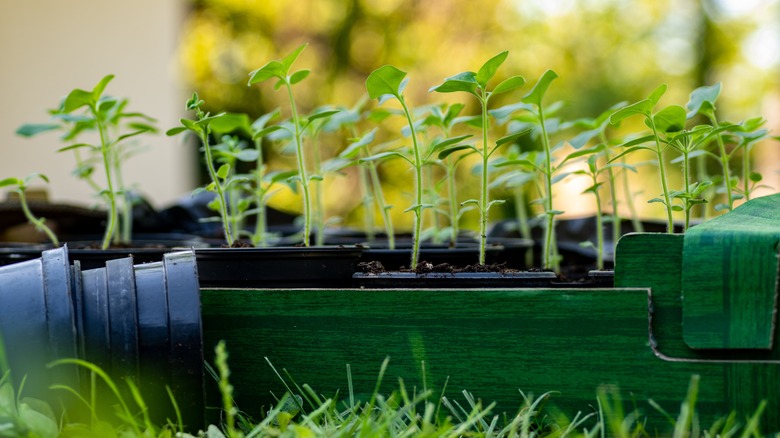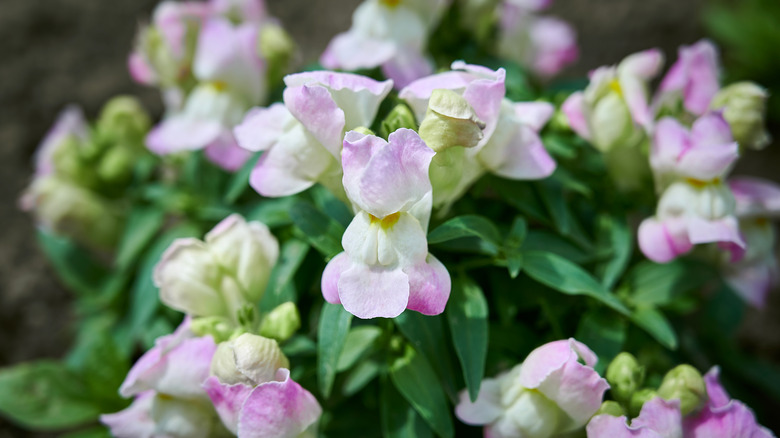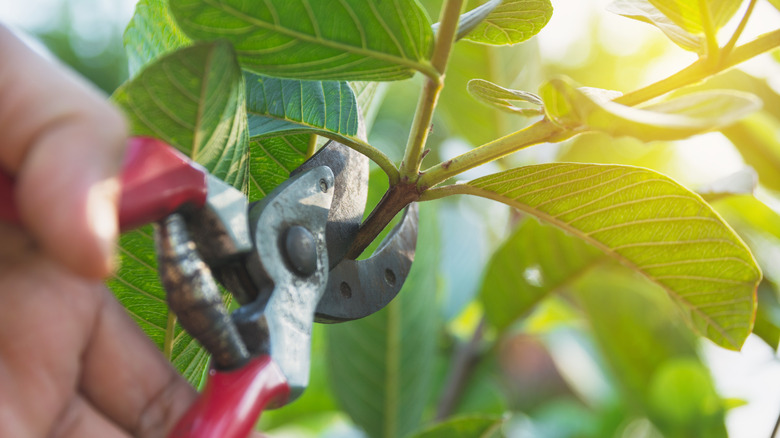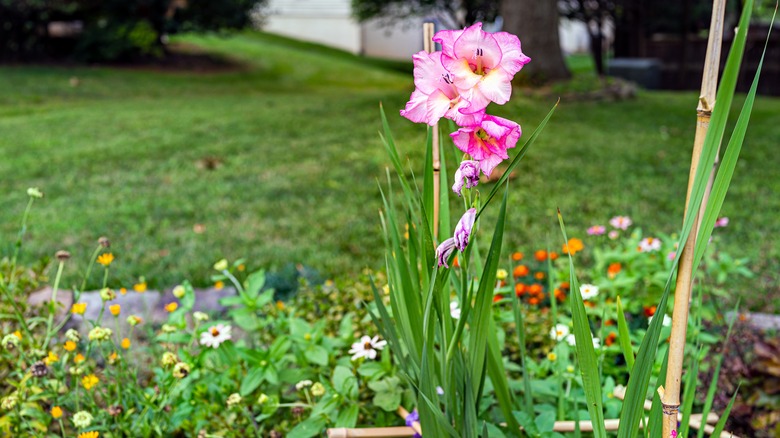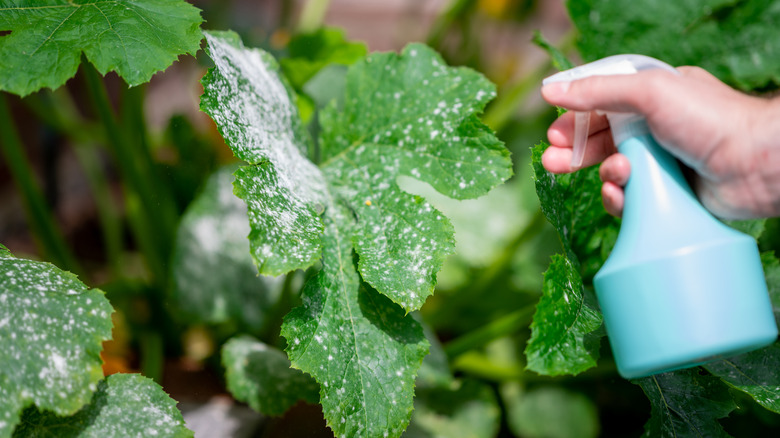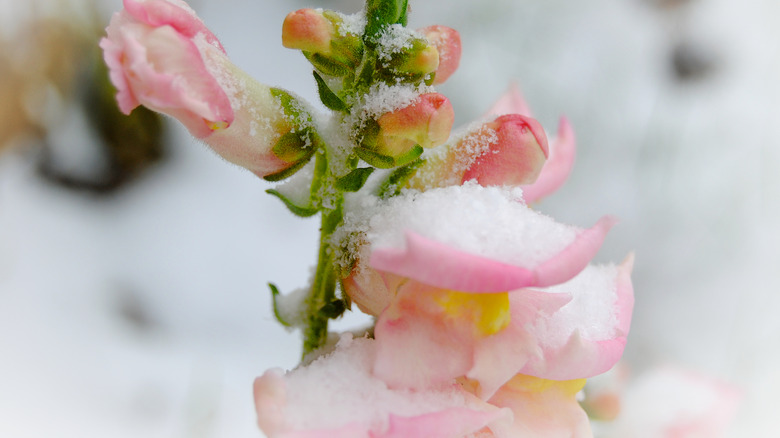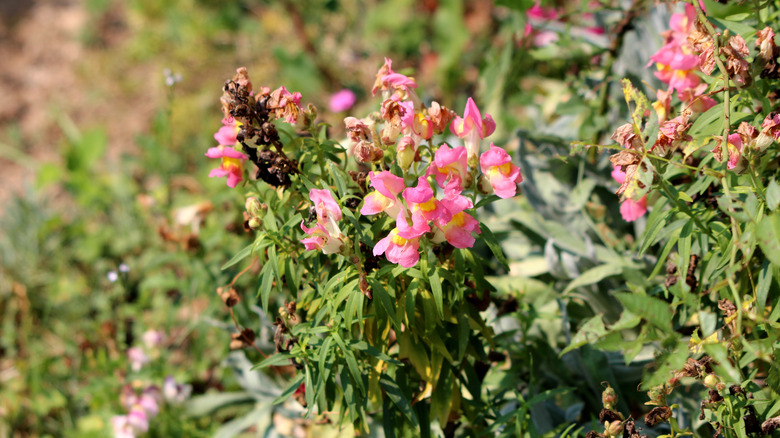How To Grow And Take Care Of Snapdragon Flowers
A flower whose name evokes an image of a mythical creature's fearsome jaw doesn't seem fit for a pretty garden, and yet, who wouldn't love a flower with the whimsical name "snapdragon?" The popular, versatile bloomer Antirrhinum majus is known as snapdragon, common snapdragon, or garden snapdragon, according to the North Carolina Extension office, which adds that the blossoms really do resemble the proboscis of a dragon. Gardening Know How shares a couple of other names for the plant: lion's mouth and calf's snout! Snapdragons are also sometimes called "dog flowers."
Water-loving snapdragons show off bright, beautiful colors to enhance any garden design. It's easy to imagine them gracing Mediterranean gardens in Italy and Spain where experts, as noted by Plant Shed, think were their native lands. We normally think of southern Europe as having drought-tolerant vegetation, but today's snapdragons are having none of it. They appreciate consistently moist conditions and rich soil.
Snapdragons have spread far beyond their roots in the sunny Mediterranean. According to MiracleGro, they can be planted anywhere from USDA plant hardiness zone 3a to 11b. Most often, the colorful flora is planted every season as an annual, but predominantly in warmer climates with optimal conditions and the right varietal, snapdragons are perennial, says Gardening Know How.
How to use snapdragons in garden
Snapdragons are a favorite plant in English cottage gardens — and in gardens around the world that mimic the classic cottage garden style, described by The Middle-Sized Garden as colorful, informal, and abundant. With varieties in a myriad of hues, snapdragons are (forgive the pun) a snap to incorporate into any garden's color scheme.
Martha Stewart has had a lot of experience mapping out gardens, and she suggests incorporating snapdragons because their range of sizes allow them to provide depth by layering the multipurpose workhorse in different parts of a planting bed. Since snapdragons come in a variety of sizes and colors, they are ideal for intermingling with other plants.
A raised bed can be a great place for your snapdragons, per Beauty Harmony Life. Larger than even the most spacious flower pots, raised beds enable gardeners to control location, soil, and drainage, all of which make Antirrhinum majus happy little plants. No room for a raised bed? Snapdragons are perfectly content in pots throughout the garden or on your porch or deck, provided you have provided them with top-notch growing conditions.
How to grow snapdragons
The perky snapdragon isn't particularly fussy about where and how it likes to grow, but it has a few non-negotiable conditions. Gardener's World spells out those immutable needs beginning with plentiful sunlight and soil that drains easily, without remaining swampy. Careful attention to watering newly-planted snapdragons will pay off once they're established, says Gardening Know How, adding that regular sprinkles will keep your snapdragons looking good. When there isn't rain, the watering should be at a rate of about 1 inch per week.
In addition to the rich, nutrient-dense soil snapdragons crave, The Spruce recommends deadheading the flowers as blooms fade. Popping off the old blossoms helps encourage new ones to show off their unique shape and enticing tints. They add that the preferred soil composition is neutral (neither too acidic nor too alkaline; test your soil to be sure it's where it needs to be). Fertilize the snapdragons when they begin to bloom. A standard fertilizer mix will work nicely.
Plant Care Today cautions that gardeners should give the flowers space, setting them in the ground with at least 6 inches of distance between seedlings. Prone to a host of pest infestations and fungal attacks, proper spacing is one way to ensure necessary ventilation for your snapdragons.
How to care for snapdragons
The care you need to devote to snapdragons is not tremendously time-consuming or onerous. With a good sunny location, steady watering, a little judiciously-applied fertilizer, and occasional deadheading, the snapdragons will reward you with fragrant blossoms that are most prevalent in the spring and fall, but which will often bloom throughout the summer if you give them a little love.
Sunshine is important for snapdragons, but as The Spruce points out, they like it best when the temperatures are cool to moderate (40 to 70 degrees Fahrenheit). If you have a hot, dry spell, be sure to give them extra water.
The feeding schedule endorsed by Gardener's World is a common one; feed weekly and nourish the plants with potash-based (high in potassium) fertilizer. If you're looking for robust plants with a bushy appearance, Garden Beast recommends cutting off the top of the flower spike before it blooms, allowing the plant to spread for a while before growing new flowers.
Snapdragon varieties
With nearly every shade except blue, snapdragons bring a rainbow of hues into your garden or flower pots. They have a wide range of heights, as well, adding to their versatility. Flower Glossary identifies approximately 40 varieties of Antirrhinum, all of which fall into two categories: summer snapdragons (which are Angelonia angustifolia, according to Gardening Channel, rather than Antirrhinum majus) and common snapdragons. Most summer species grow no larger than 18 inches while the common snapdragons vary from 9 inches to over 3 feet in height.
The Rocket variety of snapdragon is frequently seen in nurseries and garden centers. It is distinguished by it dependability and lofty height, states The Spruce. They also highlight the whimsically-named Tutti Frutti varietal, a shorter version that sports stripes on its blossoms.
Though they may be harder to find, Chantilly snapdragons will wow any visitor to your garden. These stunners grow in a trailing, vine-like pattern with long-lasting blooms, per the Gardening Channel. Another remarkable variety is the Black Prince, a unique plant with blooms that have striking very dark magenta flowers and leaves that turn purplish-bronze when colder weather arrives. Gardening Channel also raves about the Aroma Series, which confuse and delight the senses with whiffs of peach, lemon, and vanilla. Bright Butterfly snapdragons and several other varieties boast blossoms that are splayed open and don't resemble the snout of a dragon as much as they resemble azalea blooms.
Are snapdragons toxic?
There's good news for gardeners who adore their snapdragons: The pretty bloomers are non-toxic, according to Plant Care Today and Little Flower Hut. The tempting flowers that can open and close by pinching the colorful blooms won't cause problems for little curiosity-seekers who want to taste them as well as play with them.
The ASPCA specifically lists cats, dogs, and horses as being safe around Antirrhinum majus. Precocious pets who take a nibble might find your snapdragons bitter, but they won't fall ill from taking a bite or two. A note of caution, however: Those beautiful Black Prince snapdragons described above are poisonous, according to Rare Seeds. Even the seeds are toxic if eaten, says Dave's Garden. So, don't munch on the seeds of Black Prince as a snack, don't make tea out of the leaves, and don't drop the flowers into a cocktail as a garnish.
How to repot snapdragons
Occasionally, you may recognize the need to move an existing or a young snapdragon to a new location. Perhaps it's a seedling you cultivated or it has grown crowded in its existing locale. Whatever the reason, repotting your snapdragons is easy and causes the plant only nominal distress.
It's best to repot snapdragons in springtime, says The Garden Style. For best results, use a container that is bigger than the one from which the flowers are being uprooted. As with any repotting, you want to be sure the potting medium or soil provides the right environment for the plants. Garden Guides suggests incorporating some compost before plopping in your snapdragons. After all, they love fertile, well-drained soil, and compost can improve your soil so that the flowers adapt easily.
Just as when planting any snapdragons, place the newly-potted flora in a sunny location and give it regular drinks of water.
How to propagate snapdragons
Patient gardeners will purchase packets of snapdragon seeds, sowing them early indoors for transplanting in window boxes, pots, raised beds, or in the ground. Garden Beast notes that patience is needed as the seeds won't germinate for three months or so if they're planted directly in the ground.
You can harvest snapdragon seeds from the flowers you're growing, but the easier route is to snip open a seed packet purchased online or at your favorite retailer. When growing from seeds, Gardening Know How describes how to get new snapdragon plants from cuttings, which should be clipped a month and a half before the anticipated first frost in autumn. Some people opt to use a rooting hormone, which helps with propagation. They add one more method of acquiring new plants: dividing the roots of your favorite snapdragons. This method, done in late summer or fall, requires the gardener to gently pry apart the roots of an existing healthy plant, placing the divided plants (each with a bit of greenery to go with the roots) in pots to overwinter.
The most delightful way to get new snapdragon plants, however, has to be when "volunteers" show up. These plants often were self-sown from snapdragons you planted, but they also may have traveled on a gust of wind or with help from birds or other wildlife, according to Den Garden.
Snapdragon history, meaning, and folklore
Garden Guides confirms the Mediterranean origins of the snapdragon and offers several fun tidbits of information, beginning with the way ancient Greeks and Romans viewed the flower. In a world full of unknowns, people turned to the plant world for things that could keep them safe. Those ancient peoples believed snapdragons could shield them from the perils of witchcraft. There are worse things a person can wear when sporting a toga!
In Germany, attention was focused on protecting infants, so they put snapdragons to work safeguarding the little ones from harm that could befall the baby due to evil spirits. Additionally, Victorian England was known for attaching meaning to the type and color of any flower, so snapdragons were no different. Unlike in earlier times when Antirrhinum majus was a guardian against troubles, Victorians thought the snapdragons signified deception, yet contradicting that, they also thought they could reflect graciousness. Florgeous concurs; the flower could mean either dishonesty or gentility.
Perhaps the most uplifting way to think about the meaning behind snapdragons comes with giving yellow snapdragons. When you do, you're wishing the receiver good fortune and happiness. What could be better?
When and how to transplant snapdragons
In cold climates, you'll need to wait until after the last hard frost has passed to transplant seedlings into the ground. Keep in mind, though, that snapdragons do better in cooler soil and even seedlings can weather a light frost, explains Burpee. That's a good tip for growing them from seed, as well. Burpee says not to heat them from below as you would with other seedlings.
The exact timing will differ depending on where you live. Of course, the Old Farmer's Almanac is still the go-to resource for estimating frost dates, but you can assume it will be around mid to late spring unless you live in a warm climate. Harden seedlings by putting them outside during the day and taking them in overnight, especially if temperatures are expected to drop. Keep them under an awning to protect them from harsh direct sunlight. Do this for a week and it could have a positive effect on the strength of their cell walls and their ability to tolerate the shock of being transplanted.
Garden Guides points out that in mild climate zones planting snapdragons in the fall is an option. They'll be able to survive a mild winter and can blossom all the way through spring.
When planting snapdragons in the ground, dig a hole big enough to accommodate the entire root ball but not much deeper. When you backfill the soil you want to make sure it stays level with the top of the root ball (via Burpee). Give it a firm press to secure everything into place and water well. Adding mulch can benefit the root system by keeping the soil temperature steady and retaining moisture, however, you need to leave space around the stem to keep it from rotting.
Why and when you should pinch snapdragons
Snapdragons are definite candidates for pinching, a simple gardening technique that can lead to fuller, bushier plants with significantly more blossoms that continue to bloom over a longer period of time. So, is it worth the time and attention? Absolutely!
Allow seedlings to reach 4 to 5 inches tall, which should mean they've grown a few sets of leaves and at least five growth nodes. Plants Craze advises focusing on the thinnest, leggiest stems and either pinching off the top few inches with your thumb and forefinger or snipping the tops away with sharp shears. These pinched sections can be used to propagate a round of baby plants. Over time you'll notice new growth emerging from the pinched points of the original plant.
When it comes to snapdragons, the benefits of pinching outweigh any potential cons, and without it, you may end up with straggly single-stemmed plants. Taking a few minutes to pinch young plants is sure to result in multiple thicker stems, or branches, and a higher yield of flowers throughout the growing season.
Deadheading and pruning snapdragons
After finishing your initial pinching of young plants in the spring, you'll switch to deadheading in the garden. This is another gardening technique that will encourage your plants to flower again and again through the summer growing season. According to horticulture expert and gardening book author Melinda Myers, deadheading refers to the removal of spent flowers at the point where they meet the stem. She notes that deadheading will temporarily postpone the next set of blossoms, but in the meantime, it will stimulate branch and stem growth just like pinching does.
Note that snapdragons really do not fare well in high heat. It's normal for them to take a break mid-summer and resume blossoming as the temperatures lower back down. Melinda Myers refers to this as a period of stalling. She adds that healthy plants will continue to bloom right up until the onset of the first light frosts.
Per Plant Addicts, once a snapdragon plant has stopped flowering altogether it can be cut back, or pruned, all the way down to the ground. If you do so during that mid-summer stall period, you just may get a full set of blossoms decorating your garden for autumn.
How to fix drooping snapdragons
Much like gladiolus or any other tall growing flowers, snapdragons will sometimes have issues with drooping to the side. This can be caused by weakened stems or severe weather such as heavy rain and/or high winds. It can also be the consequence of them simply growing so tall they can no longer support the weight of their blossoms. Gardening bloggers at Eco Family Life add that other reasons for drooping or wilting snapdragons include excessive heat, improper watering (either too much or too little), and too much shade.
Even thick-stemmed healthy snapdragons will benefit from staking. It's a good idea to consider adding some structure and support around your seedlings from the start, note the gardeners from Organic Lawn Care Tips, because waiting until the stems are about to droop over to the side can result in damage to the root system when you dig the stakes into the ground. As the plants grow taller and taller, gently and loosely tie them to their stake a few times over. Instead of something like wire or string that can cut into the delicate flesh of the stems, try to use something softer like raffia or even strips of cloth for your ties.
If you're concerned about the look of the stakes themselves, either stick to natural materials like bamboo or paint your stakes green so they blend in with the stems. Remember too that as the plants grow and flush out, the stakes will become less and less noticeable. Finally, Organic Lawn Care Tips advises that some multi-branched plants may require more than one stake for proper balance.
Pests and diseases to watch out for with snapdragons
The University of California Agriculture & Natural Resources department lists quite a few pests to be aware of if you're growing snapdragons. Most of them, however, are relatively simple to deal with like aphids and spider mites, which often respond to insecticidal soaps and neem oil. For something like foliage-feeding caterpillars, removing them by hand is recommended. If the problem persists then controlling larvae populations with appropriate pesticides that contain spinosad may be necessary. Note that pesticide application can be the cause of a spider mite outbreak, though, because it effectively gets rid of the spider mites' natural predators.
Downy mildew, powdery mildew, and leaf spots are common fungal issues in the garden that may find their way to your snapdragons. Fungicides can help, but the best solution, according to the university, is prevention. You can expect to see excellent results if you adhere from day one to these strict but easy-to-follow guidelines: Plant your snapdragons where they will receive high levels of direct sunlight. Water them at the soil level as opposed to spraying them from the top and wetting the leaves. Ensure adequate air circulation around your plants.
How to winterize snapdragons
When you consider the fact that snapdragon blossoms can often be seen popping up through a drift of snow, it's easy to understand that they're not your top priority for winterizing at the end of the season. That said, a prolonged freeze below 28 degrees Fahrenheit is likely to cause frost damage, and any time spent outdoors below 20 degrees will be too much for them, according to Garden Guides. A thin layer of mulch will go a long way to keep them toasty throughout the winter months.
Another option, per Melinda Myers, is to dig up snapdragon plants before the ground freezes. They can be potted in containers and brought inside for the coldest months of the year. Be sure to place them in a spot that receives plenty of sunlight but doesn't get too hot. If you can't make both of those conditions happen simultaneously, move the plants to a cooler location and install grow lights to keep them growing strong.
Why snapdragons might not grow or blossom
As previously mentioned, even though snapdragons prefer cool temperatures, they still need quite a bit of direct sunlight to produce abundant flowers. If you have a poorly producing plant, the first consideration is whether it's receiving enough light and where you can move it if it's not. This may mean digging it out of the garden and replanting it in a sunnier spot. Be intentional in your process in order to reduce transplant shock and it should be able to bounce back to full health.
A proper and sufficient watering schedule is the next best defense. From there, Plant Addicts remarks that you simply might have a plant that requires help from fertilizer to reach its potential. If you've had trouble staying on track with your feeding schedule, consider making a simple spreadsheet or checklist to help you stick to a routine. On the other hand, if the fertilizer you're using isn't doing the trick, then it's time to consult a local professional and do a soil test. Tests are also available at garden centers and stores like Lowe's, who recommend a kit that provides you with everything you need for proper soil collection.
Once you receive the results of your test, you'll know exactly what kind of amendments or soil conditioners you need to use to help your plants flourish.
